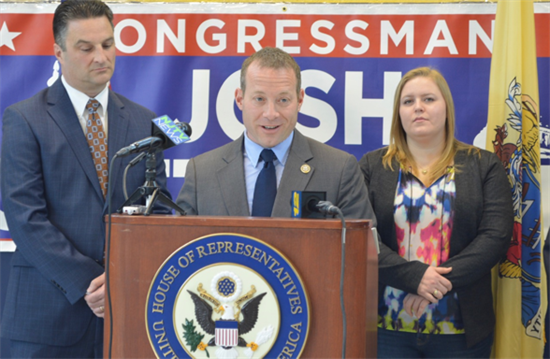
[slideshow_deploy id=’899′]
BY MIKE OLOHAN
NORTH PASCACK VALLEY AREA, NEW JERSEY—Hoping to provide a central website that includes all school districts’ water testing results statewide, U.S. Rep. Josh Gottheimer (D-Wyckoff) called on Gov. Phil Murphy Feb. 13 to require the information be publicly available.
He also called for stricter rules in reporting lead in public school drinking water.
“Exposure to lead puts our children at risk of developmental delays, learning disabilities, changes to appetite, and weight loss—all at critical stages of their growth. An even greater risk is the potential damage to brain development, which may be subtle but is often irreversible,” Gottheimer wrote Murphy.
He called for “a statewide standardized process [that] will help ensure that schools are held accountable, and being transparent with the families they serve,” he said.
Following reports in 2016 of lead-contaminated water supplies in Flint, Michigan, and Newark, New Jersey, the state ordered school districts to test their water for lead and report the results by July 12, 2017.
On average, overall lead levels were about five to six parts per billion in most Bergen County districts, with some sources above the federal standard of 15 parts per billion.
The American Academy of Pediatrics recommends remediation if lead testing results are over 1 part per billion, though the federal standard for lead in drinking water is 15 parts per billion.
Release results
Gottheimer said some districts that tested for lead last year have yet to release their results and called for them to do so. A brief survey of nearby districts in Pascack Valley and Northern Valley districts found most districts posting the results, many listing 2016-2017 lead-testing results prominently on district websites.
While Gottheimer did not state specific districts not listing results, a survey by Environment New Jersey in July found only 47 of 76 Bergen County districts provided complete results. The group stated that 35 districts reported at least one reading above 15 parts per billion.
The state requires districts provide assurance that testing has been completed but does not require submission of results. The state education department requires it be notified when results exceed the federal lead in drinking water standard.
Greater transparency
“From a general perspective, we support any call for greater transparency. Specific to this situation, we’re pleased with our actions regarding the publishing of the results on our district website and notifying the community regarding where the results may be found,” emailed Emerson Schools’ Superintendent Brian P. Gatens.
Emerson’s lead testing
At Emerson Public Schools’ website, under “Quick Links,” residents can quickly access last summer’s lead-testing results.
Last June, Emerson’s water lead testing results found only two of 17 samples taken at Patrick M. Villano School above 15 ppm. Both fixtures were removed and are no longer in use, said its report. At Memorial School, only one of 20 samples taken was over the federal “lead action level” and that kitchen sink was designated for “hand washing only.”
“Our school system is committed to protecting student, teacher and staff health. To protect our community and be in compliance with Department of Education regulations, we tested our schools’ drinking water for lead,” Supt. Brian P. Gatens wrote online.
Gatens wrote letters for each school where testing was conducted and provided overviews on the health effects of lead, how lead enters water, lead in drinking water, and resources offering more information on lead’s health impacts and how to reduce lead exposure.
“Lead in drinking water, although rarely the sole cause of lead poisoning can significantly increase a person’s total lead exposure, particularly children under the age of 6. EPA estimates drinking water can make up 20 percent or more of a person’s total exposure to lead,” Gatens wrote.
Remediation negligible
Gatens said last year’s water quality testing tab was $6,200 and $3,660 was reimbursed by the state. “The cost of the remediation work was negligible. In addition, we purchased nine filtered fill stations for $8,000,” he said.
Gottheimer said he wants all school districts to submit annual lead-testing results for public posting. In addition, he called for increased federal funding to help New Jersey’s schools fix their water-supply systems.
Currently, he said, the state pays for water testing only. Gottheimer also proposed a Lead-Free Schools Act last year to provide funds for testing and remediation of water systems with high lead levels.
[slideshow_deploy id=’899′]
Cresskill’s results
All of Cresskill’s 2016 and 2017 water-sampling results from Edward Bryan School and the Junior/Senior High School are posted online for parents and residents to access. In spring 2016, 18 locations throughout the district were found with elevated lead levels, according to Karl Environmental Group’s May 2017 report on district lead levels posted on its website.
Remediation was conducted on the drinking water outlets and after a second round of testing, nine required further remediation that was completed with lead-removing filters. After filters were added, all drinking water outlets met federal standards for drinking water, the consultant reported.
Following all testing and remediation, the consultant provided six recommendations, including replacing “any known or discovered lead piping with lead-free piping” and regularly cleaning aerators to prevent build-up of debris “which may contribute to elevated lead levels.”
Other recommendations included using cold water for food and beverage preparation, as hot water contributes to corrosion “and therefore contains a greater level of contaminants from the plumbing system.”
Also, it suggested that piping be checked for ground wiring that “may cause premature corrosion of affected piping and lead to contamination of the water.”
Elevated lead levels
Since 2102, Gottheimer said, nearly 2,000 water systems across the U.S. have found elevated lead levels in tap water samples. He said the federal Environmental Protection Agency estimates water sampling for lead in the country’s 90,000 public schools “remains inconsistent and the results are often unknown.”
Cresskill Supt. Michael Burke had not returned calls seeking comment by press time.
